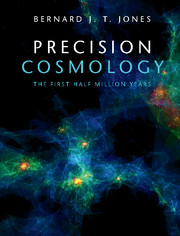Book contents
- Frontmatter
- Dedication
- Contents
- Preface
- Notation and Conventions
- Part I 100 Years of Cosmology
- 1 Emerging Cosmology
- 2 The Cosmic Expansion
- 3 The Cosmic Microwave Background
- 4 Recent Cosmology
- Part II Newtonian Cosmology
- Part III Relativistic Cosmology
- Part IV The Physics of Matter and Radiation
- Part V Precision Tools for Precision Cosmology
- Appendix A SI, CGS and Planck Units
- Appendix B Magnitudes and Distances
- Appendix C Representing Vectors and Tensors
- Appendix D The Electromagnetic Field
- Appendix E Statistical Distributions
- Appendix F Functions on a Sphere
- Appendix G Acknowledgements
- References
- Index
3 - The Cosmic Microwave Background
from Part I - 100 Years of Cosmology
Published online by Cambridge University Press: 04 May 2017
- Frontmatter
- Dedication
- Contents
- Preface
- Notation and Conventions
- Part I 100 Years of Cosmology
- 1 Emerging Cosmology
- 2 The Cosmic Expansion
- 3 The Cosmic Microwave Background
- 4 Recent Cosmology
- Part II Newtonian Cosmology
- Part III Relativistic Cosmology
- Part IV The Physics of Matter and Radiation
- Part V Precision Tools for Precision Cosmology
- Appendix A SI, CGS and Planck Units
- Appendix B Magnitudes and Distances
- Appendix C Representing Vectors and Tensors
- Appendix D The Electromagnetic Field
- Appendix E Statistical Distributions
- Appendix F Functions on a Sphere
- Appendix G Acknowledgements
- References
- Index
Summary
The ‘Renaissance in Cosmology’ took place with the discovery in 1965 by Penzias and Wilson (1965) of the Cosmic Microwave Background Radiation, now known variously as the ‘CMB’, ‘CMBR’, ‘CBR’, ‘MWB’ or simply ‘Microwave Background’ or ‘Relict Radiation’. The paper had the rather unprepossessing title of ‘A Measurement of Excess Antenna Temperature at 4080 Mc/s’ and was less than two pages. In the journal, the Penzias-Wilson paper is immediately preceded by the paper of Dicke, Peebles, Roll and Wilkinson (Dicke et al., 1965) having the title ‘Cosmic Black-Body Radiation’.
This explained that they too had been searching for this radiation field and, most importantly, explained what the significance of the discovery would be in terms of our physical understanding of our Universe (see Figure 3.3).
These two papers changed the course of cosmology.
Discovery of the CMB
During the 1950s and early 1960s the main issue was the great debate between the Steady State and Big Bang theories. This debate had centred around the apparently discrepant radio source counts in deep surveys made at different frequencies by radio astronomers in Cambridge and in Sydney.
The discovery of the cosmic microwave background radiation by Penzias and Wilson in 1965 has turned out to be decisive in establishing a new paradigm in physics: the Hot Big Bang theory (Penzias and Wilson, 1965). However, it should be recognised that the source of the excess radiation they had discovered was still under dispute even in the 1970s and it was not until the first results of the COBE-FIRAS experiment in 1990 that the issue was finally settled.
While the discovery of Penzias and Wilson was itself serendipitous, in that they were not looking for the cosmic background radiation, the idea that the cosmic background radiation was there to be found was well entrenched in both Princeton in the US and Moscow in the (then) Soviet Union. The theoretical framework for this had been set up by George Gamow, who had suggested in the late 1940s that the chemical elements were created in a Hot Big Bang and that the evidence for this would lie in the discovery of the relict radiation.
- Type
- Chapter
- Information
- Precision CosmologyThe First Half Million Years, pp. 48 - 76Publisher: Cambridge University PressPrint publication year: 2017



